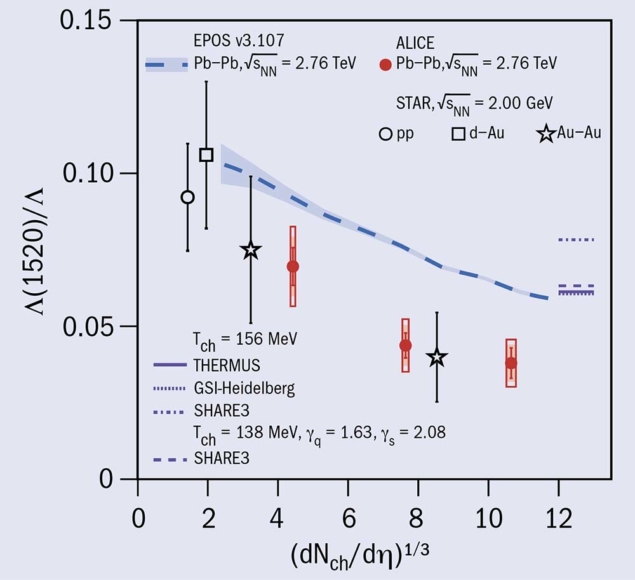
The ALICE collaboration has recently reported the first measurement of the hadronic resonance Λ(1520) in heavy-ion collisions at the LHC. In such collisions, a deconfined plasma of quarks and gluons called quark–gluon plasma (QGP) is formed, which expands and cools. Eventually, the system undergoes a transition to a dense hadron gas (hadronisation), which further expands until all interactions among hadrons cease. Short-lived hadronic resonances are sensitive probes of the dynamics and properties of the medium formed after hadronisation. Due to their short lifetimes, they decay when the system is still dense and the decay products scatter in the hadron gas, reducing the observed number of decays.
The production yield of the Λ(1520) baryon resonance was measured at mid-rapidity in lead–lead (Pb–Pb) collisions at a centre of mass energy per nucleon–nucleon pair of 2.76 TeV. The resonance is reconstructed in the Λ(1520) → pK− (and its charge-conjugate) hadronic decay channel and its production is measured as a function of the collision centrality. The ratio of the number of
measured Λ(1520) baryons to that of its stable counterpart, Λ, highlights the characteristics of resonance production directly related to the particle lifetime, since possible effects due to valence-quark composition (e.g. strangeness enhancement) cancel in the ratio. A gradual decrease of the Λ(1520)/Λ yield ratio with increasing charged-particle multiplicity is observed from peripheral to central Pb–Pb collisions (see figure).
The result provides the first evidence for Λ(1520) suppression in central heavy-ion collisions compared to peripheral collisions, achieving a 3.1σ confidence level once cancellations of correlated systematics are taken into account. An earlier measurement at lower collision energy by the STAR experiment at Brookhaven’s Relativistic Heavy-Ion Collider showed a similar suppression, but with much larger uncertainties. The ratio of the Λ(1520) resonance yield with respect to non-resonant Λ baryons reduces by about 45% in central collisions compared to peripheral collisions.
The EPOS3 model, which describes the full evolution of a heavy-ion collision and includes re-scattering in the hadronic phase, describes this suppression well, although it systematically overestimates the data. The relative decrease of the Λ(1520) resonance yield is also slightly smaller in the EPOS3 model than observed in the data, suggesting a longer lifetime of the hadronic phase (about 8.5 fm/c in EPOS3), or that the description of the relevant hadronic cross-sections in the transport phase is imprecise. The mean transverse momentum is also shown to increase with increasing charged-particle multiplicity, hence with increasing collision centrality. The EPOS3 model can quantitatively describe this feature. It is noteworthy that the model does not describe the data when the microscopic transport stage responsible for the re-scattering effect inside the hadronic medium (as described by the UrQMD model), is disabled.
In summary, these measurements add further support to the formation of a dense hadronic phase in Pb–Pb collisions, highlighting its relevance and the importance of a microscopic description of the latest stages of the evolution of heavy-ion collisions.
Further reading
ALICE Collaboration 2018 arXiv:1805.04361.





